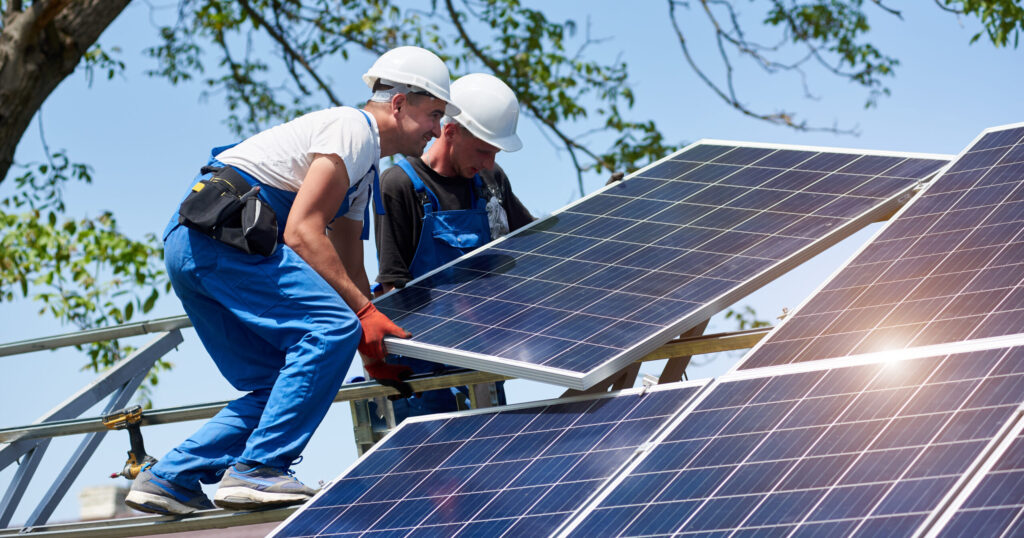At a glance
- The Inflation Reduction Act (IRA) incentivized high-road jobs standards in renewable energy construction by linking federal tax credits to fair wages and registered apprenticeship programs
- The One Big Beautiful Bill Act (OBBBA) slashed those incentives, destabilizing Maine’s energy pipeline
- Thousands of clean energy jobs for Maine’s electricians, laborers, and other trade workers may be lost and critical training programs will suffer
- Maine lawmakers can protect the state’s clean energy future by incentivizing production that meets the needs of workers and ratepayers, comprehensively tracking progress, and proactively enforcing the law to ensure workers and ratepayers get what they deserve
The Inflation Reduction Act (IRA), signed into law in August 2022, was a landmark piece of legislation that, among other things, linked renewable energy investment to high-quality, family-supporting jobs. It unleashed the rapid production of clean energy and created incentives for projects to pay fair wages and invest in registered apprenticeship programs that train workers for these essential careers.
The One Big Beautiful Bill Act (OBBBA), signed in July 2025, will terminate those incentives for wind and solar energy by the end of 2027, five years earlier than previously scheduled, with an exception for projects commencing construction by July 2026. This abrupt change threatens Maine’s growing clean-energy industry, and with it, the high-quality jobs and locally produced energy the IRA helped advance. In the wake of the new federal law, Maine lawmakers must take bold action to maintain progress towards producing more renewable energy, creating good jobs, and lowering prices for energy ratepayers.
Maine’s clean-energy footprint
According to the Climate Jobs National Resource Center, two years after the IRA’s passage, there were 129 incentive-eligible projects in Maine, in planning, under construction, or which had recently been completed. Those projects created more than 4,000 megawatts of clean power, $6.9 billion in associated investment, and more than 8,000 jobs. By May 2025, those figures had grown to an estimated 145 utility-scale projects, more than 9,100 jobs, and nearly 5,000 megawatts of power generation or storage.1 It remains to be seen how many of those projects will not come to fruition because of the new law, but workers in those trades reported a significant slowdown in jobs during negotiations and following passage of the OBBBA.
In addition to lost jobs, the termination of wind and solar energy credits is projected to significantly raise the cost of energy for ratepayers. Analysts project eliminating the IRA’s wind and solar tax credits would increase US household electricity rates by up to 10% or $400 per year by the year 2035.
Maine lawmakers can lead
With the federal government in gridlock, Maine must continue to lead toward creating good jobs while building out renewable energy infrastructure. Last session, lawmakers took important steps: creating the Department of Energy Resources and including prevailing wage requirements and incentives for Project Labor Agreements and utilization of registered apprenticeships and pre-apprenticeship programs; and committing Maine to achieving 100% clean or renewable electricity by 2040. Here are ways lawmakers can continue that progress this session:
- Develop a successor to the state’s solar subsidies. Last session, lawmakers voted to phase out Maine’s net energy billing system for community solar farms. While the program incentivized significant solar development, it failed to control costs for ratepayers or incentivize high-road labor standards. As lawmakers work toward a replacement to continue developing clean energy, the interests of consumers and workers must be front-and-center.
- Expedite project permitting. Many renewable energy projects take years to get all the permits and approvals ready to even begin construction. Lawmakers should streamline and expedite the permitting and interconnection of clean energy and storage projects to deliver affordable energy to the grid more quickly. Strong labor standards should be attached to that expedited process to ensure quick delivery does not fall on the backs of workers.
- Provide cheaper capital to lower costs. Lawmakers should utilize the state’s bonding authority to provide cheaper capital to clean energy development and grid modernization upgrades. This approach could simultaneously save ratepayers due to the lower capital costs compared to private financing sources and allow for stronger, enforceable labor standards on the work itself.
- Create a public database of renewable energy projects. LD 1850, introduced by Rep. Kilton Webb, would task state agencies like the Public Utilities Commission and Department of Environmental Protection to propose a system that breaks down information siloes and improves coordination to advance renewable energy projects. The bill passed both legislative chambers but was held and awaits action by Governor Mills.
- Proactively enforce existing standards. Existing laws include incentives for energy developers to use high-road labor standards to build future infrastructure. Since 2023, utility-scale renewable energy projects must pay prevailing wages, build out pre-apprenticeship programs, and are incentivized to sign Project Labor Agreements that improve project outcomes and costs. The Department of Labor should take a proactive approach in ensuring those commitments are being met.
- Invest in pre-apprenticeship programs. The State has an important role in balancing the supply and demand of skilled workers to build out energy infrastructure. If we make long-term commitments to produce renewable energy in the state, Maine workers will seek careers in the sector. Pre-apprenticeship programs have proven effective at preparing workers for pay-while-you-learn apprenticeships that are critical for successfully completing utility-scale projects.
Notes
[1] These figures are calculated by Climate Jobs National Resource Center with updated data using the same methodology as the 2024 report linked above and available here.


